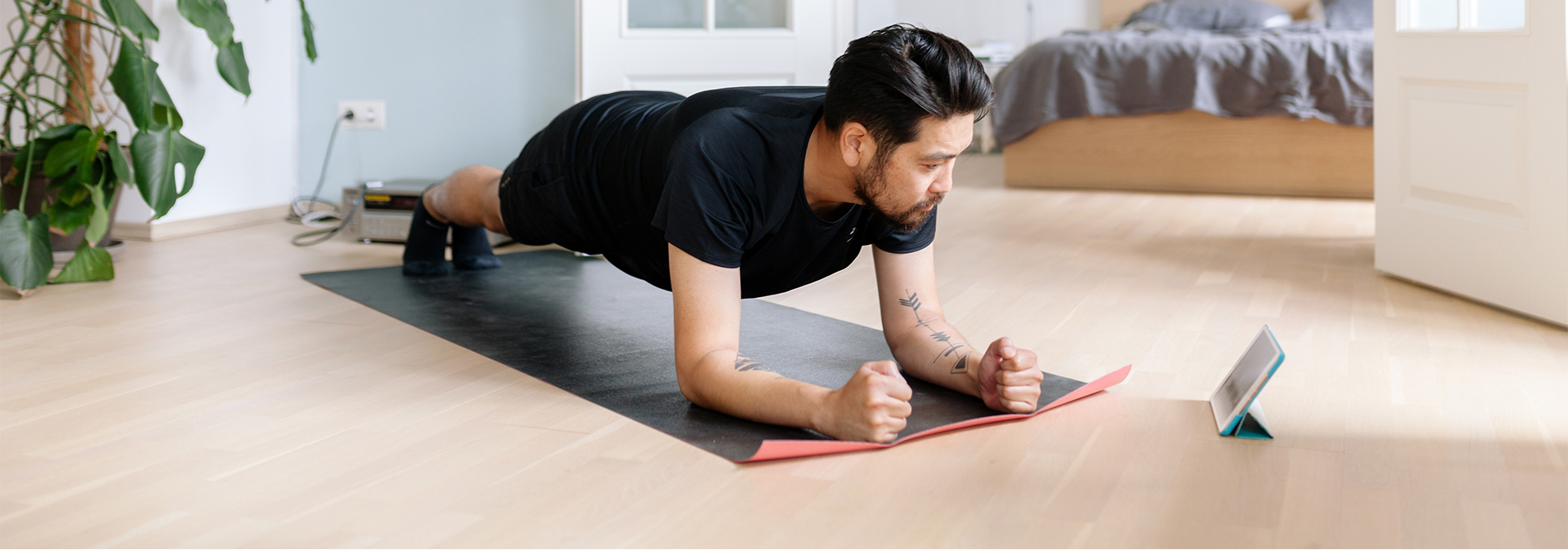You don’t need a home gym to keep your mind and body well as you practice social distancing during the coronavirus (COVID-19) pandemic. Taking five simple steps can make a difference in creating wellness in your home. Hilton’s Five Feet to Fitness™ in-room wellness concept was designed with small spaces in mind. Five Feet to Fitness typically brings the workout equipment and other health and wellness accessories to your hotel room, but many of its components can be practiced from any small space, like your living room or bedroom.
Melissa Walker, RD, ACE-CPT, Hilton’s Senior Director of Global Wellness, Customer Experience and Innovation, shares five steps to keep your mind and body fit in small spaces.
1. Get up and move – whenever you can
For those of us working from home, the days can be much more sedentary than we would experience if we were going into the office. The time spent walking to and from meetings, grabbing a coffee with a colleague or going to lunch aren’t options anymore. Now, your workday begins and ends in your living room, you’re taking meetings from your couch and you’re missing your group fitness class or time at your local gym.
“A quick walk around the neighborhood at the end of your day isn’t going to be enough for many of us,” said Walker. “Setting aside some dedicated time for a workout, where you spend 30-45 minutes getting your heart rate up is important, but you should also be thinking about how to use the five or 10 minute breaks you may have throughout the day to get up and move.”
Spend those five minutes walking up and down the stairs in your home or apartment building, do some jumping jacks or fit in a quick yoga session. These short bursts of exercise will add up throughout your day.
2. Set yourself up for success
Sore backs and hip flexors are common when we’re not working with the correct ergonomic set up, but there are a few ways you can make your work-from-home set up healthier. Start by avoiding the couch, and instead, sit in a firm chair with back support. You should also look for a countertop that can work for you as a standing desk. If your computer is too low, use books to elevate it. You should aim for a 90-degree bend in your arms, and your wrists should be supported.
Switching positions frequently can also help with aches and pains. If you have a topical analgesic at home, like BIOFREEZE©, the cooling effect can offer some relief. Walker suggests setting an alarm every 15 minutes to remind yourself to stretch. She also recommends wearing supportive shoes.
“Many of us are not used to spending as much time in our homes as we have to now, so we don’t think about what’s on our feet,” said Walker. “Slippers, socks or bare feet are a popular choice, but I recommend shoes with good arch support, like sneakers.”
Wearing supportive shoes and starting your day in clothes that you are comfortable in will put you in the right mindset to take advantage of the short breaks you have to be active. Don’t forget to hydrate frequently!
3. Body weight is all you need
You don’t need fancy gym equipment to break a sweat. Body weight exercises can get your heart pumping and can be done anywhere.
“The key to making this work is doing enough repetitions of the exercise and not resting too much between sets,” said Walker. “Once you get your heart rate up, the movement should be fairly continuous so that you get the physiological benefits.”
Squats, lunges, burpees, push-ups, jumping jacks, planks, assisted dips (leaning off the edge of a solid surface) and jumping rope are all easy to do at home. You might also be able to use everyday household items such as jugs of water or canned food to add resistance. Those items can replace kettlebells or dumbbells for arm workouts.
4. Connect with loved ones
Wellness is about more than how much we move or how healthy we eat. Emotional wellness is equally important. Walker recommends daily video check-ins with friends and family while you practice social distancing.
“Isolation is one of the quickest routes to a downward spiral that a person can experience,” said Walker. “If you live alone, social distancing during the coronavirus pandemic may be taking a toll. Do not underestimate the importance of connecting with the people you love.”
5. Practice mindfulness
Despite the challenging circumstances that come with living during a disease pandemic, experiencing and expressing gratefulness is important. There are many ways of doing this, including meditation, breath work or simply saying a grateful intention out loud. You might also find it uplifting to help others in small ways.
“Dropping off a prepared meal for your elderly neighbor or writing a note to a local schoolteacher with a thank you for helping students with lesson plans at home can go a long way in improving your and others’ emotional wellness,” said Walker. “Studies show that you have to be in the right place, emotionally and mentally, before you can improve your physical wellness.”
